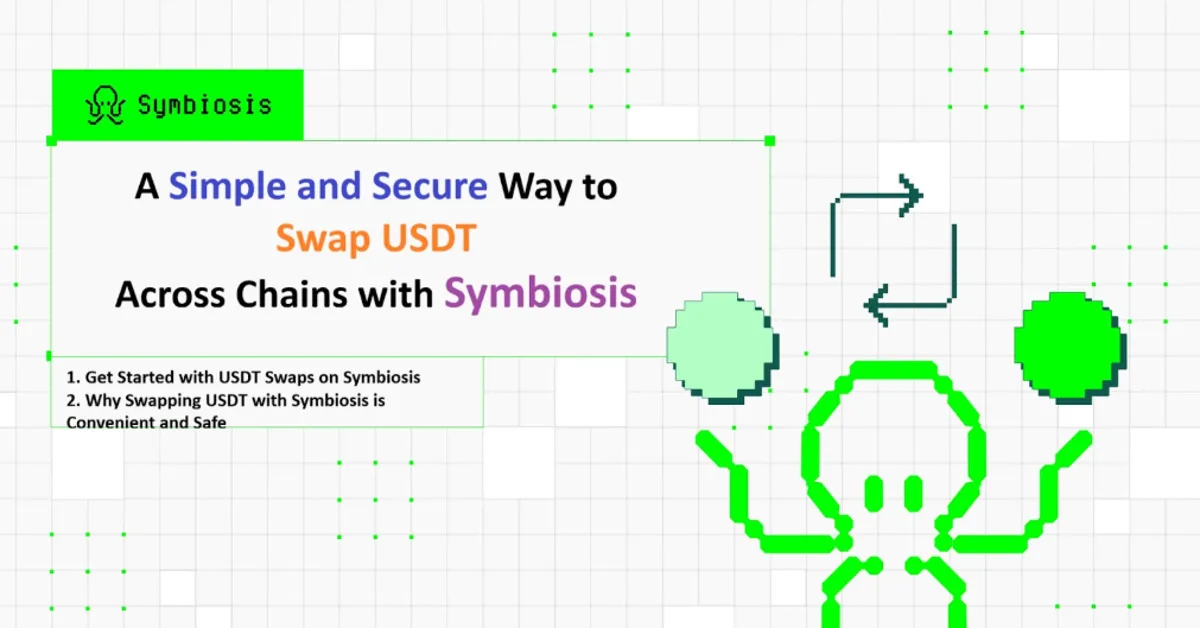In the fast-paced world of cryptocurrency, users often face one recurring challenge: how to move assets like USDT across different blockchains easily, securely, and cost-effectively. Symbiosis USDT Exchange offers a seamless solution to this problem. become more urgent than ever.
This Platform offers a seamless solution to this problem. Built to simplify the multichain experience, It allows users to swap USDT and other tokens across a wide variety of networks without needing to understand the technical differences between them. Whether you’re holding USDT on Ethereum, BNB Chain, Polygon, Tron, or Arbitrum, Symbiosis can help you move your assets where you need them all in a single transaction.
What Is Symbiosis?
Symbiosis is a decentralized exchange (DEX) protocol designed for cross-chain liquidity and swaps. It connects various blockchains in a unified interface, enabling asset transfers across otherwise incompatible networks. Its multichain architecture is what sets it apart — rather than relying on wrapped tokens or custodial bridges, Symbiosis facilitates direct, non-custodial swaps between native assets on different chains.
This means that users can trade tokens across chains like Ethereum, BNB Chain, Arbitrum, Polygon, and Tron (TRC20) without needing to interact with multiple platforms or understand complex routing logic. All the heavy lifting is done by Symbiosis behind the scenes.
Simplified Swaps with Automatic Route Selection
One of the standout features of Symbiosis is its automatic route selection. In traditional cross-chain platforms, users often need to manually choose the route for their swaps, which can be confusing and error-prone — especially for those new to DeFi. Symbiosis eliminates this complexity by automatically identifying the best path for your transaction.
The routing algorithm evaluates multiple factors in real-time, including liquidity availability, network congestion, and transaction fees. The result is a fast and cost-efficient swap experience, optimized for the current conditions on supported chains.
Whether you’re bridging from USDT on Tron (TRC20) to USDT on Ethereum (ERC20), or moving between any other supported network, Symbiosis ensures that you get the best deal without lifting a finger.
Why Swap USDT with Symbiosis?
USDT (Tether) remains one of the most widely used stablecoins in the crypto ecosystem. It’s used for everything from trading and lending to payments and remittances. However, the existence of USDT on multiple blockchains — like Ethereum, BNB Chain, Polygon, and Tron — has created a fragmented experience for users.
Symbiosis solves this by providing a unified interface for USDT swaps, allowing users to:
- Move USDT across chains in one click
- Avoid the need to use centralized exchanges or custodial bridges
- Minimize swap fees and slippage
- Eliminate the complexity of manually choosing networks
If you’re looking for a quick and secure way to convert USDT between different chains, the Symbiosis USDT exchange offers exactly that — no registration, no KYC, and no middlemen.
Seamless Wallet Integration and Privacy
A key benefit of using Symbiosis is that it works directly with your crypto wallet. Whether you’re using MetaMask, Trust Wallet, WalletConnect, or another Web3-compatible wallet, you can initiate swaps without creating an account or submitting personal information.
This approach aligns with the core principles of DeFi: non-custodial control, privacy, and ease of access. Your private keys remain under your control at all times, and transactions are executed via smart contracts that are fully transparent on-chain.
Tron (TRC20) and Low-Cost USDT Transfers
Among the supported networks, Tron (TRC20) stands out as a particularly popular option for USDT transactions. Known for its low fees and fast confirmation times, TRC20 USDT is widely used for remittances and daily transfers, especially in regions where cost efficiency is critical.
For example, sending USDT on Ethereum might cost upwards of $5–10 during peak congestion, while the same transaction on Tron often costs fractions of a cent. This makes TRC20 USDT an ideal choice for those looking to move stablecoins quickly and affordably.
You can explore more about the Tron network via TronChain.
With Symbiosis, you can easily swap TRC20 USDT to other networks — such as Ethereum or Polygon — and vice versa, without using centralised bridges or exchanges.
Broad Network Support
Symbiosis supports a growing number of popular blockchains and L2 networks, including:
- Ethereum (ERC20) – the most widely used DeFi ecosystem
- BNB Chain (BEP20) – known for its low-cost, high-speed transactions
- Polygon – a leading Ethereum scaling solution with low fees
- Arbitrum – an L2 solution offering fast and cheap transactions
- Tron (TRC20) – optimized for cheap USDT transfers
- Avalanche, Optimism, zkSync, and more
This broad network support means you can hold USDT on your preferred chain, but still interact with dApps and services across the broader ecosystem. Symbiosis becomes your gateway to multichain DeFi, with no friction.
Final Thoughts
Navigating the multichain world doesn’t need to be complicated. With Symbiosis, you can swap USDT across blockchains with just a few clicks — no manual bridging, no centralized exchanges, and no headaches.
Thanks to its smart routing, wallet integration, and support for major networks like Tron, Ethereum, and Polygon, Symbiosis makes cross-chain swaps as easy as swapping tokens within the same chain.
Whether you’re a DeFi power user or a casual investor looking for an easy way to move your stablecoins, the Symbiosis USDT exchange is worth checking out.
ALSO READ: FintechZoom.com Crypto: A Comprehensive Exploration









